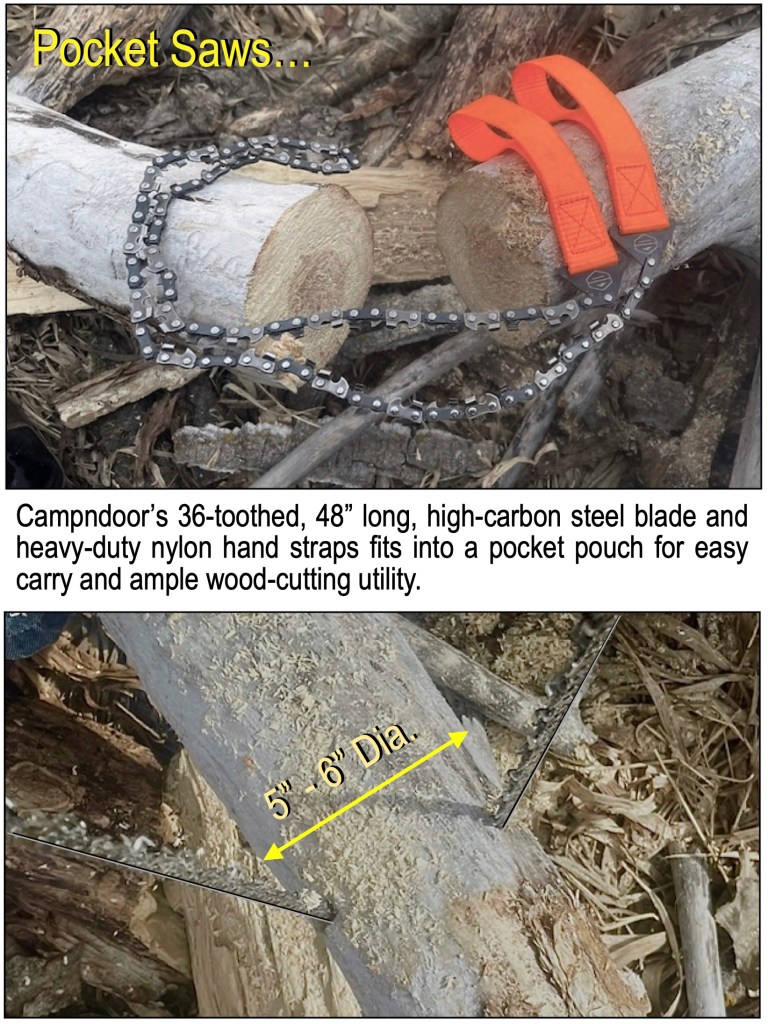(Originally published in “Self Reliance In The Outdoors” /Tom Watson / Midwest Outdoors – June,2024)
As part of my spring readiness rounds through my camping gear I always reach that fork in my mental “Do I really need this?” road. The most recurring question arises over whether or not I should bring an axe, a saw or a combo unit that converts to one or the other to fulfill the many cutting, chopping, splitting, firewood duties in camp.
Knives are never an issue. It’s the ultimate essential camp tool, no seasoned outdoors-person would argue that fact. Moving up the “cutting too l” hierarchy into the chopping utility of hatchets and axes, it becomes a little more conditional. Will I be cutting lots of wood over an extended period of time? Will I be traveling by vehicle or schlepping heavy and space-grabbing gear in a backpack?
The “hatchet” vs “axe” choice is rather simple. Processing small volumes of wood for camp (trimming, splitting, etc.) or pounding stakes can all be accomplished with a hatchet. Maintaining firewood for a week’s campout or clearing an area suggests a more effective and bigger axe.
Like a knife, sharpening hatchets and axes in the field is a direct, simple matter.
And then there are saws! Hundreds of tiny, shark-sharp teeth that slice through the wood, getting duller with every draw of the blade.
Sawing is more efficient for cutting through wood than chopping; less energy, safer and usually quicker. The most common camp saw is the bow saw, either in conventional tube frame construction or fold-down frame models. As positive as their effectiveness is, their greatest shortcoming is that they only have that one talent or virtue. You can’t chop, split, pound or do anything else with them: mono-utility.

One solution that works well depending upon the design and quality of construction are the folding saws or combo saw-hatchet units on the market. Saw blades that fold or slide into the handle are more compact that a rigid saw and are quite useful for tackling wood whose diameter is up to about two-thirds the length of the working saw blade. Some hatchets have saw blade compartments in the handles that enable the user to extract the saw blade, attach the other end to a connection at/hear the head of the hatchet and chop away. Some are flimsy, some very uncomfortable and others just not balanced to swing/chop effectively. It’s best to test one of these models out before committing for the long chop. The advantage is that you have a chopper/splitter/trimmer/saw all taking up no more space than a regular hatchet.
My newest camp wood-cutting toy is yet another option: a pocket chain saw!
Remove the toothed chain from a conventional power saw, cut the loop into one long section and add a stout handle on each end, and voila! – you have a chain saw you can coil up and store in a pocket or on your belt.

A back-and-forth pulling motion slices the teeth along the chain down through quite large sections of wood, making short work of cutting a downed tree into campfire sections as you move up/down the dried limb wielding your “chain” saw. Much safer than swinging an axe, and needing less surrounding space to accomplish a more efficient and clean cut each time. Once the target log is secured, you can buzz through a 6” limb in hardly any time at all.
The downside of any saw is its limited use. It can’t split (although initial cuts can be easily perform to give you consistent optimum splitting lengths); can’t pound/hammer with it; it requires special tools and sharpening technique (not ideal for field honing).
Each of these classic wood cutting tools works very well for the purposes for which it was initially created. We can combine tools for some uses, others might force us to prioritize our needs and processes. Which ever fork along that wood-cutting road you decide to take, you can probably narrow down your pick to one or two preferred choices.
Be Safe; Be Smart; Have fun out there!

Leave a comment